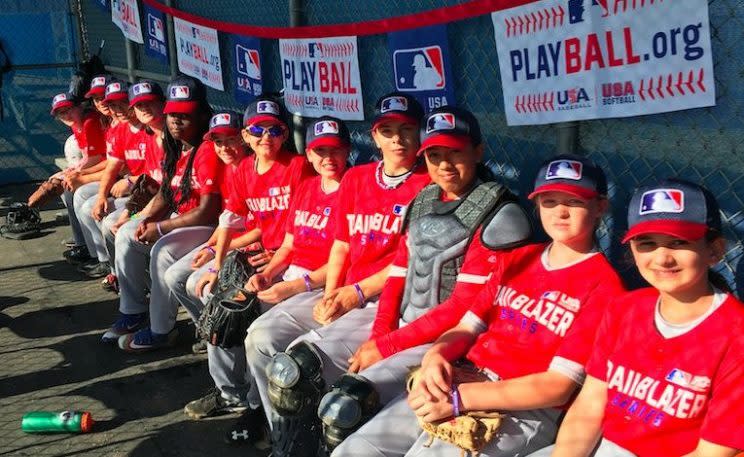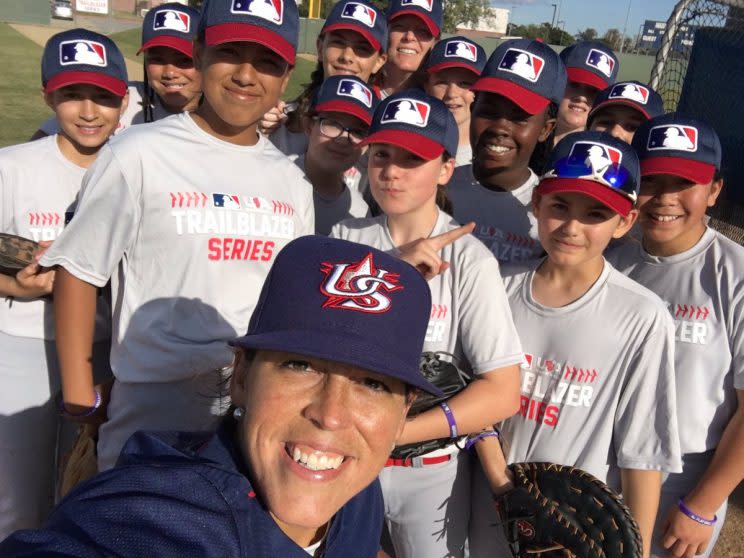MLB's Trailblazer Series was a success, but what's next for women in baseball?
The first ever Trailblazer Series, which celebrated girls baseball, took place over the weekend, and it looks like an unqualified success. One hundred young women came from across the country (and one from Canada) to play baseball, receive instruction from women’s baseball players and coaches, and take part in Jackie Robinson Day festivities at Dodger Stadium.
The event was created by Major League Baseball with a helping hand from USA Baseball, the organization that manages all amateur baseball in the U.S.
[Sign up for Yahoo Fantasy Baseball: It’s not too late to get in the game]
If you want to know how much of a success it was, all you had to do was look at social media posts from female baseball players, coaches and parents:
Girls playing baseball. I feel like I'm going to cry. #TrailblazerSeries pic.twitter.com/yL8Eneqgyd
— Rhea Butcher (@RheaButcher) April 15, 2017
Had such a blast coaching you girls during the trailblazer series this week! #IAmATrailblazer #WomensBaseball #TeamGreen #MLB #USAbaseball pic.twitter.com/39uTs3LqZt
— Stacy Piagno (@StacyPiagno) April 16, 2017
Trailblazing it up with these girls on the diamond today. An incredible wkd w/ them all! ????????❤️⚾️#TrailblazerSeries @PlayBall @USABaseballWNT pic.twitter.com/fgA0J8LA6I
— Jennie Finch (@JennieFinch) April 15, 2017
As a parent, my heart swells w pride that my daughter got to be part of #trailblazerseries w other baseball-playing girls #iamatrailblazer pic.twitter.com/TnkN3iUDA3
— Scott Whipple (@swh1pple) April 15, 2017
That’s endlessly inspirational. It’s clear that the activities of this past weekend made a huge impact on the girls and women who took part. But there’s a question about the Trailblazer Series that needs to be asked: What’s next for these young women? The purpose of the Trailblazer Series, according to MLB, was to celebrate girls baseball. It’s been celebrated. But what’s beyond that?
MLB has at least a tentative plan to support girls baseball beyond the Trailblazer Series. Tony Reagins, MLB’s Vice President of Youth Programs, told The Stew via email that MLB intends to make the Trailblazer Series a yearly event, at least in some form. That’s encouraging for people who want to see more opportunities for women in baseball. Reagins also said that the Trailblazer Series came about due to the overwhelming demand for girls baseball at a grassroots level, and that can’t be anything but positive.
“We wanted to ensure that our first official step into this world was done the right way so we relied heavily on our partners at USA Baseball in terms of extending invitations and operating all on-field activities of the Trailblazer Series,” Reagins said. “USA Baseball has been carrying the brightest torch for women’s baseball for years now and we knew they would help us make this the best possible event it could be.”
MLB’s attention to girls baseball is great, especially since it was born out of a legitimate need, but it highlights a bigger issue in the baseball universe. For almost all of these girls, their future lies in softball, or in another sport, or in no sport at all. MLB has celebrated these girls, but once they reach college age, it has nothing else to offer them. If they want to continue playing baseball, they’ll need to keep playing with boys, and when that’s no longer possible, forge their own path. But for many girls, it’s not worth it to do that when there are so few places for women to play baseball — amateur or professional — in the United States.
Take Mo’ne Davis, for example. In 2014, she helped pitch her team, the Taney Dragons, into the later rounds of the Little League World Series. She became the first girl to earn a win at the LLWS. She was a true breakout: she was a girl, and she was better than many of the boys. But not long after the LLWS, Davis said that she’d be giving up baseball to focus on basketball.
Why? There could be a lot of reasons why. Maybe she likes basketball more than baseball. Or maybe she’s better at it. (If that’s true, the WNBA better watch out.) But it could be this: as a basketball player, Davis could have a career as a professional athlete. There’s a clear path for her to follow: play basketball while finishing high school, then play college basketball at a Division I school, and then the WNBA.

There is no such path for a young woman who only plays baseball. There is no women’s baseball at the college level, so if a woman wants to play any kind of small-ball, she has to switch to softball. Beyond college, there are a number of amateur women’s baseball teams and organizations scattered across the U.S., like the Eastern Women’s Baseball Conference. USA Baseball, the governing body for amateur baseball, has a women’s national baseball team, and the Women’s Baseball World Cup has been around since 2004. But there’s no women’s professional baseball in the U.S., and no uniform, formal way for women to get involved with these disparate amateur teams.
MLB does want to make sure that girls get the opportunity to play baseball if they want to, and that goes beyond the Trailblazer Series. But not yet far enough that it would create such a path to baseball as a legitimate livelihood.
“One of the most underreported elements of the Trailblazer Series,” Reagins said, “was that USA Baseball sought out and received re-affirmations from their National Member Organizations, which sanction leagues across the country and around the world, to work toward growing opportunities for girls to play baseball.”
Translation: That could lead to more opportunities in the future. Other more immediate avenues involve MLB’s Play Ball initiative, in which it works with USA Baseball to encourage increased participation in the game. That includes girls. MLB’s seven Youth Academies (Compton, Houston, Cincinnati, New Orleans, Philadelphia, Dallas and Washington D.C.) are opening their doors too.
“We have directed all of our Youth Academies to allow girls to play baseball should they so choose,” Reagins said.
Between now and the next Trailblazer Series, MLB has no plans to host additional baseball events. It plans to let USA Baseball take the lead for the rest of the year and lend support where it can. That plan makes sense, but it also shows the big issue here: For baseball to grow among women, there needs to be something beyond USA Baseball.
Sarah Hudek is a great example. In 2015, Hudek accepted a scholarship to pitch on the baseball team at Bossier Parish Community College in Louisiana, where she played on a team of all men. And in 2016, Hudek transferred from BPCC to Texas A&M … to play softball. Hudek never explicitly said why she switched, but in the Instagram post that announced it, she said she was excited “to have the opportunity to possibly play for a national championship one day.” She wouldn’t have that opportunity playing baseball for BPCC, but switching to Texas A&M and their nationally ranked Division I softball program means she would. Even some of the most dedicated female baseball players have nowhere to go, and the benefits of switching over to softball are too great to ignore.
The amount of work to be done here is almost comically overwhelming. But if MLB wants girls to choose baseball over softball, there has to be a future in it. And the only way for there to be a viable future for women’s professional baseball is for MLB to create it from the ground up. Ken Rosenthal wrote an excellent article on Fox Sports last week about what MLB is doing to try to increase the number of African-American players in baseball, and a massive, well-funded operation like that is what girls baseball would need just to start. High schools and colleges would have to be convinced to offer the sport, which would be a Herculean task as it would reduce the amount of money that baseball and softball get at the same levels. And there’s even more work to do beyond that to set up a system and infrastructure for women’s pro ball.
Can all this work actually be done? That question is important, but not as vital as this one: does MLB even know this work needs to be done? Reagins said that MLB plans to do more to support girls who play baseball, but what comes next? If the interest in girls baseball is growing, what happens when these girls become women and their opportunities to play baseball almost entirely disappear?
Nothing should take away from the weekend, and how meaningful the Trailblazer Series clearly was for many of the participants. And it’s laudable that MLB wants to celebrate these girls, many of whom are fighting against a lot of adversity to play the game they love. But this isn’t enough yet.
On the day of the Trailblazer Series, Play Ball tweeted a picture of the girls from the tournament along with a picture of the Jackie Robinson statue at Dodger Stadium. It read: “#TrailblazerSeries meets the ultimate trailblazer. #IAmATrailblazer”
The sentiment is nice, but it’s not a reality. Not yet. And maybe not ever. The truth is these girls have nowhere to go in baseball after adolescence. If MLB truly wants to make a difference, it needs to prioritize girls baseball before those smiling faces from the Trailblazer Series become women with nowhere to go but the softball field.
More MLB coverage from Yahoo Sports:
– – – – – –
Liz Roscher is a writer for Big League Stew on Yahoo Sports. Have a tip? Email her at lizroscher@yahoo.com or follow her on twitter! Follow @lizroscher



